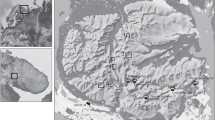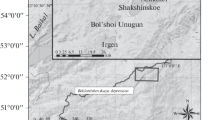Abstract
Acidification of lakes takes place when pH of rainwater is less than 4.5 and the catchments lie on sensitive geology. Both conditions are met for most lakes in Bohemia and Slovakia. Since 1978 we have studied mountain lakes in the Sumava and in the High Tatra Mountains.
In Šumava the three lakes under study are of glacial origin. The catchments are small, with steep sides covered by spruce. The bedrocks are biotite-rich paragneiss, together with gneiss, quartzite and granite. In summer 1936 surface pH was 5.7–6.9 in the Lake Čertovo and 6.9–7.0 in the Lake Černé. Now the pH values are 4.3–4.8 in the two lakes and in the Lake Prášilské as well. Old reports on zooplankton are from the years 1871, 1892–96, 1935–37, 1947 and 1960. Since 1979 we have not found any planktonic Crustacea in the lakes Černé and Čertovo. Lake Prášilské is inhabited by Daphnia longispina and Cyclops abyssorum. In July 1989 the pH values were 4.4, 4.7 and 4.7, concentrations of labile monomeric Al were 0.83, 0.68 and 0.24 mg l-1 in the lakes Čertovo, Černé and Prašilské, respectively. High levels of toxic Al compounds might be responsible for the extinction of planktonic Crustacea in the lakes Čertovo and Černé. All the three lakes are void of fish at present.
In the High Tatra Mts. we examined more than 40 lakes above timberline in altitudes 1612–2145 m. They are all clearwater, naturally fishless lakes. The bedrock is granite. Owing to different levels of calcium the lakes are now in different stages of acidification. According to recent changes in the zooplankton they can be divided into three groups: (1) Species composition of planktonic Crustacea has not changed. (2) Planktonic Crustacea were present until 1973 but are absent now. (3) From the original species of Crustacea only Chydorus sphaericus is present.
The three groups are well separated along the gradients of calcium, ANC and pH. They can be identified with the Henriksen's bicarbonate (our group 1), intermediate (our group 2) and acid (our group 3) lakes. We suppose that in the process of acidification the lakes of the group (2) have been shifted from oligotrophy to ultraoligotrophy.
Similar content being viewed by others
References
Almer, B., W. Dickson, C. Ekström & E. Hörnström, 1978. Sulphur pollution and the aquatic ecosystems. In J. O. Nriagu (ed.), Sulphur in the environment, part II: Ecological impacts. Wiley, New York: 271–311.
Arzet, K., 1987. Diatomeen als pH-Indikatoren in subrezenten Sedimenten von Weichwasserseen. Diss. Abt. Limnol. Innsbruck, 266 pp.
Berzins, B. & B. Pejler, 1987. Rotifer occurrence in relation to pH. Hydrobiologia 147/Dev. Hydrobiol. 42: 107–116.
Brett, M. T., 1989. Zooplankton communities and acidification. Wat. Air Soil Pollut. 44: 387–414.
Brtek, J., 1977. Anostraca, Notostraca, Conchostraca, Calanoida Slovenska. Acta Rer. Natur. Mus. Nat. Slov. 23: 117–150, Bratislava.
Carter, J. H. C., W. D. Taylor, R. Chengalath & D. A. Scruton, 1986. Limnetic zooplankton assemblages in Atlantic Canada with special reference to acidification. Can. J. Fish. aquat. Sci. 43: 444–456.
Cerovský, M., 1983. Meranie znečistenia ovzdušia na Chopku a srážek v Bratislave [Measurement of air pollution at Mt. Chopok and pollution of precipitation in Bratislava]. Hydrogeochemical problems of water pollution, Geological Survey, Bratislava: 73–80.
Dougan, W. K. & A. L. Wilson, 1974: The absorptiometric determination of aluminium in water. A comparison of some chromogenic reagents and the development of an improved method. Analyst 99: 413–430.
Fott, B., 1937. Zwei neue Arten der Gattung Diceras Reverdin (In Czech, with German summary). Mém. de la Soc. Royal de Bohême, Classe Sci., 1936, 7 p., Prague.
Fott, B., 1938. Eine neue Gymnodinium- und Massartia- Art. Studia Botanica Čechoslovaca, 1: 100–104, Prague.
Fott, J., E. Stuchlík & Z. Stuchlíková, 1987. Acidification of lakes in Czechoslovakia. In B. Moldan & T. Paces (eds), Extended abstracts of the International workshop on geochemistry and monotoring in representative basins. Geological Survey, Prague: 77–79.
Fott J., E. Stuchlík, Z. Stuchlíková, V. Straškrabová, J. Kopáček & K. Šimek, 1992. Acidification of lakes in Tatra Mountains (Czechoslovakia) and its ecological consequences. In R. Mosello, B. M. Wathne & G. Guissani (eds), Limnology on groups of remote lakes: ongoing and planned activities. Documenta Ist. Ital. Idrobiol. 32: 69–81.
Frič, A., 1872. Über die Fauna der Böhmerwald-Seen. Sitzungsberichte der königl. böhmischen Gesselschaft der Wiss., Jahrgang 1871, Prague: 1–13.
Frič, A. & V. Vávra, 1897. Untersuchung zweier Böhmerwaldseen, des Schwarzen Sees und des Teufelssees. Arch. d. naturw. Landesdurchforschung von Böhmen, 10: 1–74, Prague.
Havas, M. & T. C. Hutchinson, 1983. The Smoking Hills: natural acidification of an aquatic ecosystem. Nature 301: 23–27.
Havens, K. & J. DeCosta, 1985. An analysis of selective herbivory in an acid lake and its importance in controlling phytoplankton community structure. J. Plankton Res. 7: 207–222.
Havens, K. & J. DeCosta, 1986. The role of aluminium contamination in determining phytoplankton and zooplankton responses to acidification. Water, Air and Soil Pollution 33: 277–293.
Henriksen, A., 1980. Acidification of freshwaters — a large scale titration. Proc. int. conf. ecol. impact acid precip., Norway, SNSF project: 68–74.
Hörnström, E., C. Eckström & O. Duraini, 1984. Effects of pH and different levels of aluminium on lake plankton in the Swedisch west coast area. Nat. Swed. Board of Fish., Inst. of Freshw. Research Drottingholm, Lund, Report No 61: 115–127.
Hrbáček, J., J. Brtek, M. Vranovský & O. Štěrba, 1974. Zooplankton and significant representatives of some groups of the Tatra lakes minute water animals (In Czech with English summary). Treatises concerning the Tatra National Park, 16: 105–109.
Jírovec, O. & M. Jírovcová, 1937. Le chimisme des lacs de la Šumava [Forêt Bohême] (In Czech with French summary). Mém. de la Soc. Royal de Boheme, Classe Sci., 1937, 21 pp., Prague.
Kopacek J. & E. Stuchlik, 1994. Chemical characteristics of lakes in the High Tatra Mountains, Slovakia. Hydrobiologia 274/Dev. Hydrobiol. 93: 49–56.
Koste, W., 1978. Rotatoria I. Textband. Gebrüder Borntraeger, Berlin, 673 pp.
Landa, V., K. Novák & T. Soldán, 1984. Changes of pH values of surface water at selected localities of the Upper Vltava, Lužnice and Otava basins in 1959 (1956) and 1981 (In Czech with English summary). Acta Musei Bohemiae merid. in České Budějovice, Sci. Nat. 24: 1–12.
Lorenzen, C. J., 1967. Determination of chlorophyll and phaeopigments: spectrophotometric equations. Limnol. Oceanogr. 12: 343–346.
Lydén, A. & O. Gratin, 1985. Phytoplankton species composition, biomass and production in Lake Gardsjön — an acidified clearwater lake in SW Sweden. Ecological Bulletins 37: 195–202, Stockholm.
Mackereth, F. J. H., J. Heron & J. F. Talling, 1978. Water analysis: some revised methods for linmologists. FBA scientific publication No 36, 120 pp.
Minkiewicz, S., 1917. Die Crustaceen der Tatraseen. Bull. Acad. Sci. Cracovie, cl. mathem. natur., Nov.–Dec. 1916: 262–278, Kraków.
Moldan, B., 1991. Atmospheric deposition: a biogeochemical process. Rozpravy Československé akademie věd, řada MPV, 101: 1–108, Prague.
Morling, G. & B. Pejler, 1990. Acidification and zooplankton development in some West-Swedish lakes, 1966–1983. Limnologica 20: 307–318.
Nillsen, J. P., T. Ostdahl & W. T. M. Potts, 1984. Species replacements in acidified lakes: Physiology, predation or competition? Nat. Swed. Board of Fish., Inst. of Freshw. Research Drottingholm, Lund, Report No. 61: 148–153.
Popovský J. & L. A. Pfiester, 1990. Dinophyceae (Dinoflagellida). Süsswasserflora von Mitteleuropa, Gustav Fischer Verlag, Jena, Stuttgart, 272 pp.
Røegeberg, E. J. S. & A. Henriksen, 1985. An automatic method for fractionation and determination of aluminium in fresh-waters. Vatten 16: 48–53.
Schindler, D. W., 1988. Experimental studies of chemical stressors on whole lake ecosystems. Verb. int. Ver. Limnol. 23: 11–41.
Sprules, W. G., 1975. Midsummer crustacean zooplankton communities in acid-stressed lakes. J. Fish. Res. Bd Can. 32: 389–395.
Šrámek-Hušsek, R., 1942. Revision der Cladoceren- und Eucopepodenfauna des Schwarzen Sees in Böhmerwald nach 66 Jahren. (In Czech, with German summary). Mém. de la Soc. Royal de Boême, Classe Sci., 1942, Prague, 22 pp.
Strickland, J. D. H. & T. R. Parsons, 1968. A practical handbook of seawater analysis. Bull. Fish. Res. Bd Can., 167 pp.
Stuchlík, E., Z. Stuchlíková, J. Fott, L. Růžička, & J. Vrba, 1985. Effect of acid precipitation on waters of the TANAP territory. (In Czech, with English summary). Treatises concerning the Tatra National Park 26: 173–211.
Swedish Environmental Protection Agency, 1991. Quality Criteria for lakes and watercourses, 32 pp.
Veselý, J., 1985. Kyselé povrchové vody [Acid surface waters]. In J. Černý (ed.), Kyselá atmosférická depozice a její důsledky [Acid atmospheric deposition and its impact]. Ecological section of the Czechoslovak Biological Society, Prague: 31–38.
Veselý, J., P. Beneš & K. Ševčík, 1989. Occurrence and speciation of beryllium in acidified freshwaters. Wat. Res. 23: 711–718.
Veselý, J. & V. Majer, 1992. The major importance of nitrate increase for the acidification of two lakes in Bohemia. In R. Mosello, B. M. Wathne & G. Guissani (eds), Limnology on groups of remote lakes: ongoing and planned activities. Documenta Ist. Ital. Idrobiol.: 83–92.
Vyhnálek, V., J. Fott & J. Kopáček, 1994. Chlorophyllphosphorus relationship in acidified lakes of the High Tatra Mountains (Slovakia). Hydrobiologia 274/Dev. Hydrobiol. 93: 171–177.
Weiser, J., 1947. Klimnologickým výzkumům na Černém jezeře [Limnological investigations of the Černé Lake]. Příroda 40: 30–31, Prague.
Wright, R. W., N. Conroy, W. T. Dickson, R. Harriman, A. Henriksen & C. L. Schofield, 1980: Acidified lake districts of the world: a comparison of water chemistry of lakes in southern Norway, southern Sweden, the Adirondack Mountains of New York, and southeastern Ontario. Proc. int. conf. ecol. impact acid precip., Norway, SNSF project: 377–379.
Yan, N. D. & R. Strus, 1980. Crustacean zooplankton communities of acidic, metal-contaminated lakes near Sudbury, Ontario. Can. J. Fish. aquat. Sci. 37: 2282–2293.
Author information
Authors and Affiliations
Rights and permissions
About this article
Cite this article
Fott, J., Pražáková, M., Stuchlík, E. et al. Acidification of lakes in Šumava (Bohemia) and in the High Tatra Mountains (Slovakia). Hydrobiologia 274, 37–47 (1994). https://doi.org/10.1007/BF00014625
Issue Date:
DOI: https://doi.org/10.1007/BF00014625




